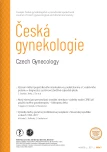Role of umbilical interleukin-6, procalcitonin and C-reactive protein measurement in the diagnosis of fetal inflammatory response syndrome
Authors:
Straňák Z. 1,2; Berka I. 1,2; Širc J. 1,2; Urbánek J. 1; Feyereisl J. 1,2; Korček P. 1,2
Authors‘ workplace:
Ústav pro péči o matku a dítě, Praha
1; 3. LF UK, Praha
2
Published in:
Ceska Gynekol 2021; 86(2): 80-85
Category:
Original Article
doi:
https://doi.org/10.48095/cccg202180
Overview
Objective: Fetal Inflammatory Response Syndrome (FIRS) is a serious complication accompanied by increased neonatal mortality and morbidity. Early diagnosis of FIRS is essential to detect high risk infants. The aim of the study was to evaluate the correlation between interleukin-6 (IL-6), procalcitonin (PCT), C-reactive protein (CRP) in cord blood and histologically proven funisitis/ chorioamnionitis in high-risk infants after preterm birth. Methods: Blood sampling for the measurement of inflammatory biomarkers was performed immediately after placental delivery and umbilical cutting. Umbilical and placental inflammatory changes were assessed using a recently released scoring system (Amsterdam Placental Workshop Group Consensus). Results: One hundred preterm infants (30.5 ± 2.5 gestational week, birth weight 1,443 ± 566 grams) and 21 health term infants were analyzed. Histologic chorioamnionitis was confirmed in 19% cases and chorioamnionitis with funisitis in 7% cases. Thirty-three infants (33%) fulfilled criteria of FIRS (funistis and/ or umbilical IL-6 > 11 ng/ L). The presence of FIRS correlated significantly with maternal leukocytosis (P < 0.001), preterm premature rupture of membrane (P < 0.001) and preterm uterine contraction (P < 0.0001). In comparison to preterm and healthy term infants we found statistically significant higher levels of umbilical inflammatory biomarkers (IL-6, PCT, CRP) in FIRS group (P < 0.0001). Composite mortality and morbidity (bronchopulmonary dysplasia, intraventricular haemorrhage, periventricular leukomalacia) was higher in FIRS group (28.1 vs 22.4% in preterm group). However, the difference was not statistically significant (P = 0.53). Conclusion: Our study confirmed the correlation of umbilical inflammatory biomarkers levels (IL-6, PCT, CRP) and the presence of FIRS. We did not find significant adverse impact of FIRS on neonatal mortality and morbidity. Nevertheless, our results could be influenced by the size of study group and strict inclusion criteria (only cases after C-section were analyzed).
Keywords:
fetal inflammatory response syndrome – neonatal mortality – morbidity – interleukin-6 – C-reactive protein – procalcitonin – chorioamnionitis and funisitis
Sources
1. Gomez R, Romero R, Ghezzi F et al. The fetal inflammatory response syndrome. Am J Obstet Gynecol 1998; 179(1): 194–202. doi: 10.1016/ s0002-9378(98)70272-8.
2. Jung E, Romero R, Yeo L et al. The fetal inflammatory response syndrome: the origins of a concept, pathophysiology, diagnosis, and obstetrical implications. Semin Fetal Neonatal Med 2020; 25(4): 101146. doi: 10.1016/ j.siny.2020.101146.
3. Hofer N, Kothari R, Morris N et al. The fetal inflammatory response syndrome is a risk factor for morbidity in preterm neonates. Am J Obstet Gynecol 2013; 209(6): 542.e1–542.e11. doi: 10.1016/ j.ajog.2013.08.030.
4. Khong TY, Mooney EE, Ariel I et al. Sampling and definitions of placental lesions: Amsterdam placental workshop group consensus statement. Arch Pathol Lab Med 2016; 140(7): 698–713. doi: 10.5858/ arpa.2015-0225-CC.
5. Vtoxfor.zendesk.com. Manuals and forms. 2020 [online]. Available from: https:/ / vtoxford.zendesk.com/ hc/ en-us/ categories/ 360 000861394-Manuals-and-Forms.
6. Maisonneuve E, Ancel PY, Foix-L’Hélias L et al. Impact of clinical and/ or histological chorioamnionitis on neurodevelopmental outcomes in preterm infants: a literature review. J Gynecol Obstet Hum Reprod 2017; 46(4): 307–316. doi: 10.1016/ j.jogoh.2017.02.007.
7. Chiesa C, Pacifico L, Natale F et al. Fetal and early neonatal interleukin-6 response. Cytokine 2015; 76(1): 1–12. doi: 10.1016/ j.cyto.2015.03.015.
8. Oh JW, Park CW, Moon KC et al. The relationship among the progression of inflammation in umbilical cord, fetal inflammatory response, early-onset neonatal sepsis, and chorioamnionitis. PloS One 2019; 14(11): e0225328. doi: 10.1371/ journal.pone.0225328.
9. Ruan L, Chen GY, Liu Z et al. The combination of procalcitonin and C-reactive protein or presepsin alone improves the accuracy of diagnosis of neonatal sepsis: a meta-analysis and systematic review. Crit Care 2018; 22(1): 316. doi: 10.1186/ s13054-018-2236-1.
10. Sarno L, Della Corte L, Saccone G et al. Histological chorioamnionitis and risk of pulmonary complications in preterm births: a systematic review and meta-analysis. J Matern Fetal Neonatal Med 2019 : 1–10. doi: 10.1080/ 14767058.2019.1689945.
11. Shi Z, Ma L, Luo K et al. Chorioamnionitis in the development of cerebral palsy: a meta-analysis and systematic review. Pediatrics 2017; 139(6): e20163781. doi: 10.1542/ peds.2016-3781.
Labels
Paediatric gynaecology Gynaecology and obstetrics Reproduction medicineArticle was published in
Czech Gynaecology

2021 Issue 2
Most read in this issue
- Current possibilities in the prevention and therapy of ovarian hyperstimulation syndrome
- Giant breast fibroadenoma in pregnancy
- Obstetric anal sphincter injury and anal incontinence
- A new instrument to personalize ovarian stimulation: results of the CERES study after using a novel gonadotropin – follitropin delta
